The Museum Collections
Introduction
I. History and Art Collection
1. Icons of the 14th – 19th centuries
icons of the 14th – 17th century
2. Jewelry art of the 14th – 20th century
jewelry art of the 14th – 17th century
jewelry art of the 18th – 19th century
the european silver 14th - 19th centuries
3. Small-size sculptures (works of metal, wood, bone)
XI – the beginning of the XX century
Small-size sculptures 11th – 17th century
Small-size sculptures 18th – early 20th century
enamel of Troitza masters 15-8th – early 20th century
5.Embroidery, lace, textiles of the 14th - early 20th century
gold and silver lace
6.Painting of the 18th – 21st centuries
painting of the 18th – 19th centuris
painting of the 20th – 21st centuris
II.Manuscripts and old printed books of the 14th – 17th century
IV.Lithography of the 18th – 19th century
V.Numismatics
VI.Medals of the 18th - early 20th century
VIII.Archeology collection
IX. Russian folk and applied and decorative art of the 17th – 21st c.
1. Artistic wood
folk carved and painted wood
wooden toys
house carving of Sergiev Posad
Khokhloma and Gorodets painting
2. Artistic textiles
embroidery and weaving
printed textiles and lace
Russian shawls
folk costumes
folk garments
printed cotton kerchiefs
|
The collection of wooden toys in the Sergiev-Posad museum(P.1) |
In the collection of the Sergiev-Posad museum wooden toys are presented by the several trade centers, which concentrated in Moscow (Sergiev Posad city with Bogorodsky village) and Nizhniy Novgorod Region (Gorodetz & Semenov cities, Fedoseevo & Polkhov Maidan villages).
The considerable place in the museum collection occupy the national paints of Sergiev-Posad artists. The well-known Trinity St.Sergius monastery exerted influence on the creativity and activity of these masters: the art traditions, which developed here and inflow of numerous pilgrims promoted to development of several toy crafts in the Sergiev Posad and its vicinities.
In beginning of 19th century Sergievsky Posad already was recognized "capital of a toy kingdom». The local market amazed buyers with variety of the wooden goods: fine-moulded eggs, rattles, fungi, carts of joiner's work, and also wooden carved and painted "dolls" - figures of "Hussar", "Mistress", "Wet-nurse", "Dandy" and other characters.
The type-setting toy "Trinity St. Sergius Lavra » was the most popular since 1860s. It represented itself a wooden box, which easily kept within recognized samples of monastic constructions; the monastery plan was applied on a set.
From the middle of 19th century the greatest distribution is received by inexpensive toys from a papier-mache and mastic with simple movement, a soundtrack (peep) and details from a fabric, feathers, bugles and other materials. Special wooden «billets» used for their manufacture. Models were glued by several layers of a paper, dried up, and then cut on two parts, which stuck together among themselves, grounded and painted.
The small collection of toys 19th – 20th centuries executed by Sergiev Posad masters is stored in museum. Among them dolls "Mistress" and "Hussars", toys from papier-mache and a type-setting toy "Trinity St. Sergius Lavra”. The big interest is represented by Easter eggs, Christmas-tree decorations, and miniature boxes-caskets
|
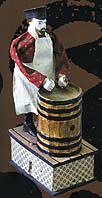
1. Papier-mache toy. Unknown author. 19th century
|

2. Papier-mache toy. Unknown author. 19th century
|
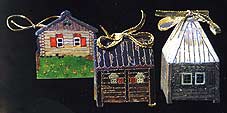
3. Fur-tree toys. Author Vl. I.Sokolov. 1910s.
|
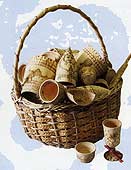
4. Set for sand-game. Early 20th century
|
In 1891, the educational toy workshop under the guidance of V.I.Borutskogo was opened in Sergiev Posad. The Commercial and industrial museum of handicraft products (further to: the Handicraft museum) saw for the workshop’s work.
New homecraft of art handling of a wood have arisen in the city thanks to diligence of zemstvo: joiner-carved, burning out and painting on a wood, manufacture of dolls in historic-ethnographic suits, and manufacturing of nested dolls (matryoshka).
Matryoshka has appeared in Sergiev Posad in 1904, handicraft workshops have redeemed assortment of samples of toys of the Moscow masterful A.I.Mamontov, which worked at shop «Children's education».
The fast recognition of matryoshka in Russia also has abroad provided to it a priority place in the trade goods of Sergiev Posad. Thanks to efforts of masters there was a considerable quantity of variants of matryoshka. In subjects of painting «Russian style» prevailed. Nested dolls (matryoshka ) were embodied in images of peasants, boyars, epic heroes, historical and literary characters, sometimes their form was used for an illustration of fairy tales.
The rare samples of nested dolls executed in an educational toy workshop of the Moscow provincial “zemstvo” are presented in museum collection. Among which are matryoshka: "Copyist", "Grandfather", "Tsarevna-swan", etc.
The big interest represents N.D.Bartram's works. A series of the nested dolls executed by 100-year-old anniversary of N.V.Gogol is stored in a museum, - «Taras Bulba», « Zaporozhye’s man », etc. For a hallmark of the artist, use in a decorative painting of nested dolls receptions of easel art was characteristic.
In 1900th years, local icon painters were engaged in a painting of nested dolls. In museum collection matryoshka are presented in masterful D.Pichugin, the hereditary icon painter of Trinity St.Sergius monastery. Among them : "Boyar man", "Boyar woman". Nested dolls are dressed in the stylised multilayered suits of "pre-Peter Russia» - long-skirt the fur coats, edged by fur, caftans, “letnik” (ancient top lady's wear), high caps.
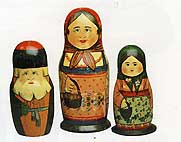
5.Matryoshka (nested dolls). 1910s
|
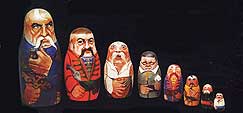
6. Matryoshka «Taras Bulba». Author N.D.Bartram
|
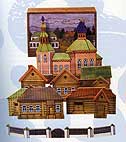
7. Toy "Manor". Author N.D.Bartram. 1910s.
|
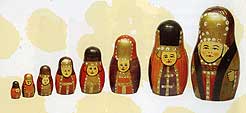
8. Matryoshka "Boyar women". Early 20th century.
|
|


